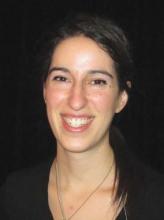SAN DIEGO – The total recurrence rate of ovarian dermoid cysts in a pediatric and adolescent population following cystectomy is 11%, and evidence of recurrence that requires a second operative management is 3%.
Moreover, the method of surgical intervention – laparoscopy or laparotomy – does not appear to influence the rate of cyst recurrence, Erin Rogers reported at the annual meeting of the North American Society for Pediatric and Adolescent Gynecology.
Dermoid cysts can represent up to 70% of benign ovarian tumors in women under age 30, said Ms. Rogers, a medical student at Queens University, Kingston, Ontario, Canada. "They have a slow growth rate and on average have been seen to grow at 1.8 mm per year."
The general presentation is an asymptomatic woman who has dermoid cysts that are discovered incidentally through imaging for other reasons. However, some patients can present with abdominal pain or an abdominal mass, she said.
The preferred way to image dermoid cysts is by ultrasound. Clinicians "manage them expectantly if they’re small and not growing that quickly," Ms. Rogers said. "Expectant management involves routine imaging every 6-12 months. Surgery is generally indicated if the cysts reach 4-5 cm in size or if they grow at a rate greater than 2 cm per year. Surgical management includes cystectomy or laparoscopy."
In a study conducted at the Hospital for Sick Children in Toronto, Ms. Rogers and her associates set out to determine the rate of dermoid cyst recurrence after cystectomy in a pediatric/adolescent population; evaluate if the mode of surgery impacts the rate of recurrence; and develop a postsurgical follow-up protocol for dermoid cysts. They retrospectively evaluated 66 patients under age 18 treated with dermoid cystectomy at the hospital between January 2003 and June 2012. Data collected included follow-up information, imaging, and demographic information. Recurrence was defined as any evidence of dermoid cyst on postoperative imaging.
The average age of patients at the time of surgery was 13 years, and the initial cyst size was an average of 8 cm. More than half of patients (61%) underwent laparoscopy, and the rest underwent laparotomy. The follow-up for patients "was quite varied," she said. "This is because the management of these patients is at the discretion of the managing physician." More than one-third of patients (39%) were followed with a single postoperative visit and no ultrasound imaging; 9% were followed with a single follow-up visit and ultrasound; and 53% were followed annually with a follow-up visit and ultrasound.
Seven of the 66 patients had a recurrence (11%). Of the patients with a recurrence, 5 were treated expectantly with imaging alone and 2 were followed with a second operation.
Recurrence occurred in 15% of patients treated with laparoscopy and 4% of patients treated with laparotomy, a difference that did not reach significance (P = .23). However, about 5% of patients who were treated initially with a laparoscopic procedure showed evidence of recurrence that required a second surgery, while none who were treated with a laparotomy showed evidence of recurrence that required a second surgery.
Based on the study results, Ms. Rogers and her associates propose that dermoid cysts treated with cystectomy should involve a single follow-up visit with an ultrasound 12 months postoperatively. "At that time, if there is no dermoid cyst on ultrasound, these patients can be discharged to the care of their family physician or pediatrician and advised to seek medical attention if they have any symptoms that may suggest recurrence," she said. If a dermoid cyst or a cyst of unknown origin is seen on ultrasound, "we suggest that they be followed with a second ultrasound in 3-6 months. If there is no evidence of a dermoid cyst at that time, that cyst can be presumed to have been a functional cyst, and patients can seek medical attention as needed. However, if a dermoid cyst is seen on ultrasound, we suggest they be treated expectantly, with repeat ultrasounds every 6-12 months. We can consider surgery if they become symptomatic or seem to grow at a rapid rate."
Ms. Rogers said that she had no relevant financial conflicts to disclose.


